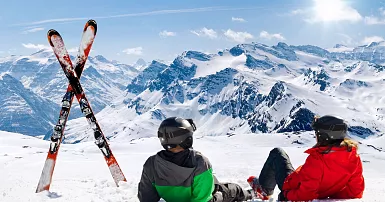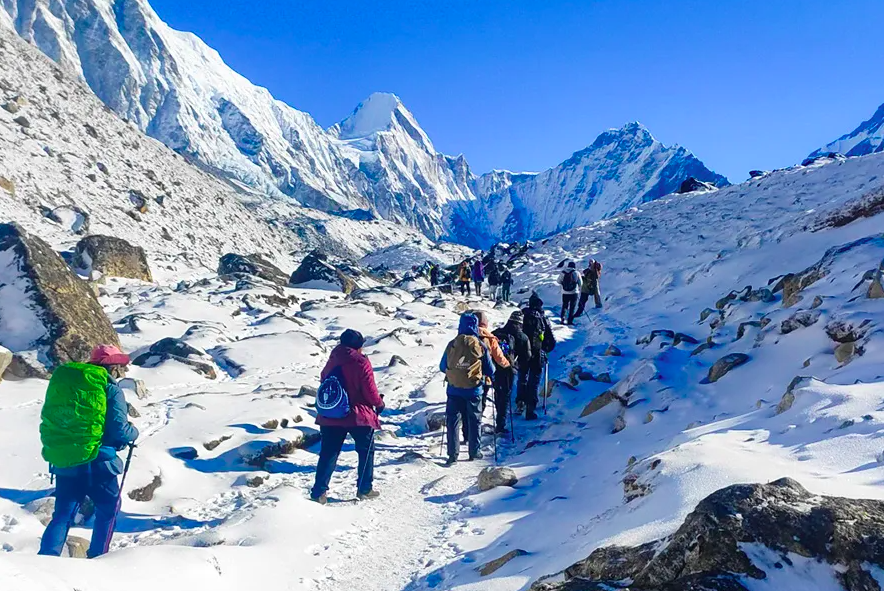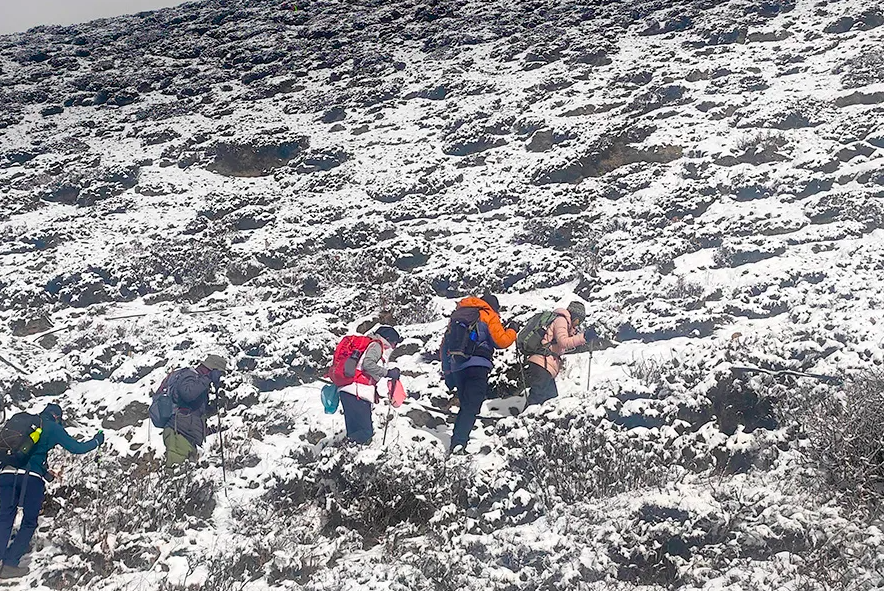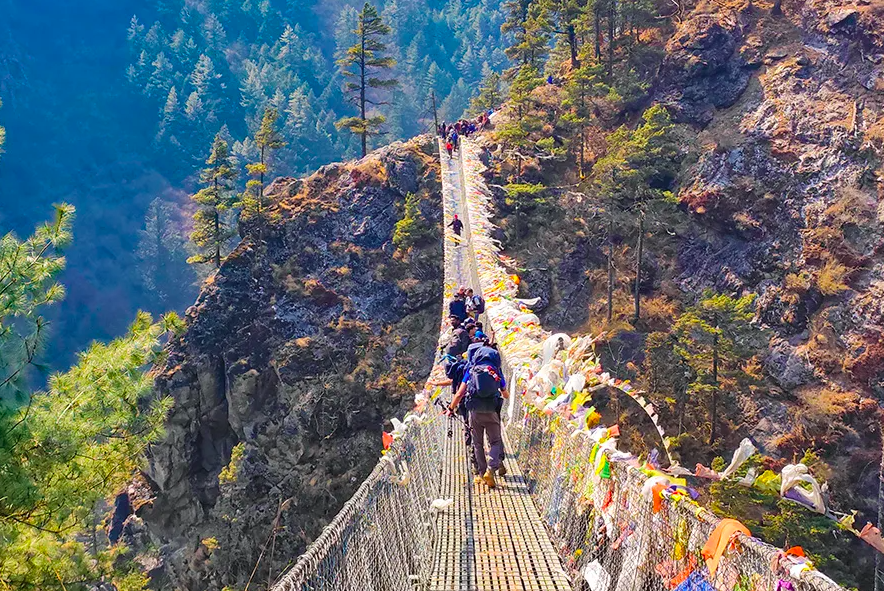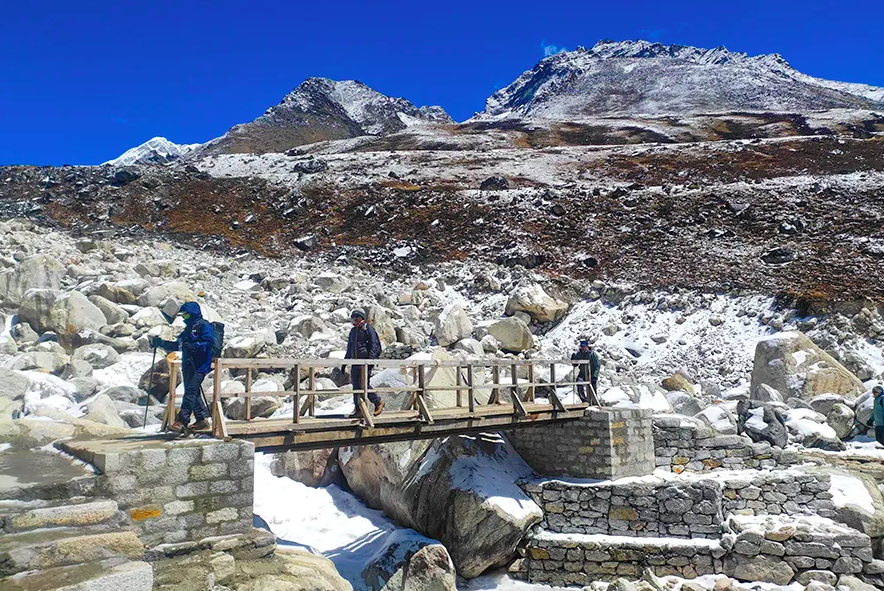Month:March | April | May | September | October | November |
Everest Base Camp Trek
Days: 13
Adventure Type: Trekking
Base Camp: Kathmandu
Season:Summer | Autumn |
Month:March | April | May | September | October | November |
Country: Nepal
Altitude: 18200 Ft.
Grade: Difficult
Rail Head: Kathmandu is not connected to any Railways
Stay: Hotel and teahouse
Food: Meals while on trek & at Hotel/Guesthouse (Veg & Eggs)
Location: Kathmandu
Distance: 112 Km.
Trail Type: Circle trail | Camping in various locations, starting and ending at the same point.
AirPort: Kathmandu (Tribhuvan International Airport)
Dreame Highlight
- Lukla flight, Food & Stay in Kathmandu included.
- Services from Delhi to Delhi.
Day-1: Arrive At Kathmandu
- Altitude(Kathmandu): 1,400 m/ 4.600 ft
Altitude: Lukla - 2,850 m/ 9,350 ft | Phakding: - 2,600 m/ 8,500 ft.
Trek Distance(Lukla to Phakding): 7 km | 4-5 hrs.
Note: Flights to Lukla are prone to delay due to weather, keep 3-4 buffer days in your plan.
- Altitude: 3,450 m/ 11,300 ft.
- Trek Distance: 10 km | 7 hrs.
- Today is acclimatization day.
- You can hike up to Sherpa Cultural Museum to get a view of Everest and Ama Dablam.
- It’s worth exploring the town, a good place to buy trekking gear.
- ATMs, internet cafes, shops, and restaurants are available at extra cost.
- Stay in the guesthouse.
- Altitude: 3,850 m/ 12,650 ft.
- Trek Distance: 11 km | 5 - 6 hrs.
- Altitude: 4,350 m/ 14,250 ft.
- Trek Distance: 12 km | 6-7 hrs.
- Rest Day helps you acclimatize well to high altitudes.
- A small hike today will show you the world’s six tallest peaks including Lhotse (8,516 m), Makalu (8,463 m), and Cho Oyu (8,188 m).
- From another location, you can see the Imja Khola Valley and Dingboche Valley.
- Altitude: 4,950 m/ 16,200 ft.
- Trek Distance: 6 km | 4-5 hrs.
- Altitude: Gorakshep - 5,150 m/ 16,900 ft | Everest Base camp - 5,350 m/ 17,700 ft.
- Lobuche To Gorakshep : 6 km | 3-4 hrs.
- Gorakshep To EBC : 3 km each way | 3hrs.
- Altitude: Kalapatthar - 5,550 m/ 18,200 ft | Pangboche - 4,000 m/ 13,100 ft.
- Gorakshep To Kalapatthar: 2 km each way | 3 - 4 hrs.
- Gorakshep To Pangboche: 19 km | 7-8 hrs.
- Altitude: 3,450 m/ 11,300 ft.
- Trek Distance: 14 km | 6 - 7 hrs.
- Altitude: Phakding - 2,600 m/ 8,500 ft | Lukla - 2,850 m/ 9,350 ft.
- Trek Distance: 16 km | 7 - 8 hrs.
Day-13: Fly Back To Kathmandu | Bid Adieu To The Mountains
- Morning flight to Kathmandu.
- Your trek to Everest Base Camp is over.
- Note: Weather conditions may cause flight cancellations. Delays are possible any time of the year but are more typical on summer departures. Keep 3-4 buffer days .
Accommodation (as per the itinerary):
Cost Includes
- Day 1 and Day 13 Hotel Accommodation in 3 Star Hotel in Kathmandu with Bed & Breakfast.
- Day 2 to Day 12 Accommodation in Teahouse.
- 2. Meals (Veg + Egg):
- All meals Lukla to Lukla from Day 2 Lunch to Day 13 Breakfast
- Fresh fruit after dinner every day.
- 3. Support:
- 1 Versatile base camp manager handles communication and deploys extra manpower in emergencies.
- 1 Mountaineering & First aid qualified professional trek Leader.
- Local experienced guides (Number of guides depending on the group size).
- Enough support staff.
- 4. Trek equipment:
- Sleeping bag.
- Gaiters & Crampon (if required).
- 5. First aid:
- Medical kit, Stretcher, Oxygen cylinder, Blood pressure monitor, Oximeter, Stethoscope.
- 6. Transportation (as per the itinerary):
- Arrival Departure Airport Transfer as per itinerary.
- Domestic airport transfers for Lukla.
- Kathmandu to Ramecchap /Lukla, and back.
- 7. Clock room facility available at the base camp for additional luggage.
- 8. All necessary permits and entry fees, up to the amount charged for Indian.
- 9. Services from Kathmandu to Kathmandu.
- 10. TIMS card.
- 11. EBC Map.
- 12. Farewell Dinner in Kathmandu.
- 13. Trek Completion Certificate
- 14. Complementary Trekking Kit Bag (Duffle bag if opted for Porter facility)
Cost Excludes
- 1. Insurance (Mandatory).
- 2. Food during the transit.
- 3. Any kind of personal expenses.
- 4. Mule or porter to carry personal luggage.
- 5. Emergency evacuation, hospitalization charge, etc.
- 6. Anything not specifically mentioned under the head Inclusion.
- 7. Extra Expenses.
- Porters for the personal bag*.
- Wifi, charging batteries, and hot showers.
- Customary gratuities for guides & porters.
- 8. Nepal entry visa (approximately USD 40, Bring Two Passport Size photos) only for foreigners (Not for Indians).
- 9. Unforeseen costs due to flight cancellation, weather conditions, etc.
- 10. Extra night accommodation in Kathmandu.
- Things can be provided on demand and availability (participant has to pay extra for these things).
- 1- Satellite phone/set phone - a type of mobile phone that connects via radio links via satellites orbiting the Earth instead of terrestrial cell sites like cell phones. Therefore, they can operate in most geographic locations on the Earth's surface.
- 2- Gamow/PAC HAPO Bag (Portable Hyperbaric Bag) - is a unique, portable hyperbaric chamber for the treatment of acute mountain sickness (AMS), also known as altitude sickness.
- 3- AEDs (Automated External Defibrillators) - are portable life-saving devices designed to treat people experiencing sudden cardiac arrest, a medical condition in which the heart stops beating suddenly and unexpectedly.
What is the Everest Base Camp trek?
The Everest Base Camp trek is a popular trekking route in Nepal that leads to the base camp of the world’s highest peak, Mount Everest. It is located in the Khumbu region of Nepal, at an altitude of approximately 18,200 ft above sea level. The trek shows the stunning views of Mount Everest and surrounding peaks and also gives a wonderful opportunity for trekkers to experience the local Sherpa town and culture.
The trek to Everest Base Camp usually takes about 13-14 days including acclimatization days. Trekkers start their adventure upon arriving in Kathmandu, then proceed through key destinations such as Lukla, Phakding, Namche Bazaar, Tengboche, Dingboche, Lobuche, Gorakshep, and finally Everest Base Camp, and Kala Patthar.
Lukla is one of the most adventurous and thrilling airports you will ever get to see. It is located at a high altitude with a very short runway. The further journey provides the beautiful experience of Sherpa culture, Namche Bazaar, food, and a glimpse of mountain peaks. In the high altitude, the area is rugged, but still in some parts, fertilization can be seen. There are monasteries where one can offer prayers and the Everest Memorial, dedicated to climbers who lost their lives during their ascent of Mount Everest.
The best time for the Everest Base Camp trek is during Summer and Autumn. In these periods, the weather conditions are at their best and the views of the mountains are clear. And if we talk about specifically the best months to visit EBC are March, April, May, September, October, and November.
Trekkers are treated to the best sunrises over Everest in the early morning light. Along the way, they can explore vibrant local places like Namche Bazaar Sherpa town and monasteries. Namche Bazaar is a famous market for shopping, and you can collect souvenirs. During the trek, you will go through Sherpa towns and can experience the Sherpa culture, as well as the serene Tengboche Monastery, an important spiritual site with panoramic views of the surrounding peaks. The people of Sherpa culture are very helpful and are considered superhumans, as they are very acclimatized to that area and very well experienced in tackling any situation.
Although the EBC trek is not challenging while trekking, it’s difficult due to high altitudes. With every new spot, the altitude rises and the chances of Acute Mountain Sickness (AMS) are very common. It is strictly guided to have a regular exercise routine before going to the EBC trek to ensure you’re physically ready. Our Trek Leaders emphasize the importance of staying hydrated and provide continuous guidance to help you manage the altitude. With the right preparation and support, you can make the most of this incredible journey.
Our Leaders also guide trekkers to always inform them if they feel any uneasiness or discomfort during the trek. This proactive approach will help for early intervention to prevent minor issues from escalating. However, our trek leaders are highly trained and can often recognize signs of altitude sickness or fatigue through body language and symptoms before trekkers even mention them. They provide timely guidance to ensure a safe and enjoyable trek.
Some key points as trekkers, we should always be aware of and keep in mind for a healthy trek.
- Keep drinking plenty of water. It is important in preventing Acute Mountain Sickness (AMS) and its symptoms, such as headaches and nausea.
- Eat regularly. Consuming protein bars and other energy-rich snacks will help in keeping your energy levels up throughout the trek.
- Keep using moisturizers and lotions to prevent sunburn and keep your skin healthy in the harsh mountain environment.
The altitude of Everest Base Camp is approximately 18,200 ft.
Yes, trekkers are required to obtain permits for the Everest Base Camp trek. However, when you trek with TTH, all the necessary permit arrangements are taken care of on your behalf. This means you can focus entirely on enjoying your journey without the hassle of paperwork. TTH ensures that everything is in order, so you can embark on your adventure worry-free.
While prior trekking experience is not mandatory, it is highly recommended. The trek involves long days of walking at high altitudes, so a good level of fitness and some trekking experience can be beneficial. It is important to prepare well with physical fitness and exercise before going on the EBC trek.
One can also follow the TTH fitness chart, which includes essential exercises specifically designed for high-altitude treks. The chart outlines the recommended exercises along with the optimal time and duration for each, allowing you to plan your fitness routine effectively. This structured approach ensures you’re well-prepared for the challenges of trekking at higher elevations.
Accommodations along the Everest Base Camp trek are in teahouses or lodges, offering a unique and immersive experience. You’ll be staying in some of the highest villages, and get a rare opportunity to witness the daily lives and customs of the local Sherpa communities. These lodgings not only offer a comfortable place to rest but also allow you to engage with the rich cultural traditions and lifestyles of people living in the remote corners of the Himalayas. Each stop along the route offers a chance to experience the warmth and hospitality of the mountain communities and adds a deeper dimension to your trekking adventure.
At higher altitudes, weather conditions can be highly variable and unpredictable. You should be prepared for cold temperatures, as well as the possibility of snow and rain.
The temperature at Everest Base Camp (EBC) varies significantly depending on the time of year. During the summer months, from March to May, temperatures at EBC are generally mild, ranging from 15-16°C during the day. However, nighttime temperatures can drop considerably, falling to around 0°C to -2°C, and sometimes even lower.
During the autumn months, from September to November, temperatures at EBC can plummet to around -7°C, and in some cases, they can be even colder. These lower temperatures can make the environment quite challenging, especially for those unprepared for the cold.
Given these temperature variations, trekkers must be well-prepared with appropriate warm clothing and gear. Layered clothing, including thermal base layers, insulated jackets, and high-quality gloves and hats, will help ensure comfort and protection against harsh conditions. Additionally, having proper sleeping gear and thermal liners will make nights at the base camp more bearable. Being prepared for these temperature extremes will enhance your trekking experience and help you enjoy more.
Preparation includes physical training, obtaining necessary permits, packing appropriate gear, and acclimatizing to high altitude.
Some essential points to keep in mind while preparing for the Everest Base Camp (EBC) trek:
- Warm Clothing: Layering is key. Pack thermal wear, insulated jackets, and warm layers to keep yourself comfortable in varying temperatures. A good base layer, fleece jackets, and a down jacket are recommended to manage the cold.
- Waterproof Jacket and Pants: A high-quality waterproof, and windproof jacket and pants will protect you from rain, snow, and strong winds.
- Permits: Obtain all necessary permits and documents. TTH typically handles these permits for you.
- Sturdy Trekking Boots: Go for well-fitting trekking boots with good ankle support. They should be waterproof and have a robust grip to handle rocky and uneven terrain.
- Sleeping Bag: Choose a sleeping bag rated for cold temperatures, with a temperature rating suitable for sub-zero conditions. This ensures you stay warm during chilly nights.
- Trekking Poles: Trekking poles help with balance and reduce strain on your knees, especially on steep or uneven trails. Adjustable, lightweight poles are best for this trek.
- Sunglasses, Sunscreen, and Lip Balm: Protect yourself from the high-altitude sun. Pack UV-protective sunglasses, high-SPF sunscreen, and moisturizing lip balm to prevent sunburn and chapped skin.
- Personal Medications and First Aid Kit: Bring any personal medications you may need, along with a basic first aid kit. This should include items for treating minor injuries, altitude sickness, and common ailments.
Altitude sickness is a risk on high-altitude treks. To minimize the risk, ascend gradually, stay hydrated, and allow time for acclimatization. If symptoms occur, it’s important to update your trek leader and they will help you with the best guidance and might provide medical attention if needed.
Some essential points to keep in mind while preparing for the Everest Base Camp (EBC) trek:
- 1. Physical Fitness: Ensure you are in good physical condition. Engage in regular cardio, strength training, and endurance exercises to prepare your body for the trek.
- 2. Acclimatization: Allow time for proper acclimatization to high altitudes to prevent Acute Mountain Sickness (AMS). Follow a gradual ascent plan and adhere to rest days.
- 3. Permits: Obtain all necessary permits and documents. TTH typically handles these permits for you.
- 4. Packing: Pack appropriate gear, including warm clothing, waterproof layers, sturdy trekking boots, a high-quality sleeping bag, and trekking poles.
- 5. Hydration and Nutrition: Stay hydrated and maintain a balanced diet. Carry energy-boosting snacks like protein bars and keep up with regular water intake.
- 6. Health and Safety: Inform your trek leader if you feel unwell at any point. Follow their advice and be aware of AMS symptoms.
- 7. Weather Conditions: Prepare for varying weather conditions. Even during favourable seasons, temperatures can drop significantly, especially at higher altitudes.
- 8. Carry Sufficient Cash: There are no ATMs in Lukla, so it’s crucial to bring enough cash for emergencies. Additionally, Kathmandu offers some of the best and most affordable options for purchasing trekking equipment, so ensure you have sufficient funds for both emergencies and any gear you may need.
Yes, most teahouses offer charging facilities, but there may be a small fee for using them. Bring a power bank as a backup to ensure you have enough power for your devices.
